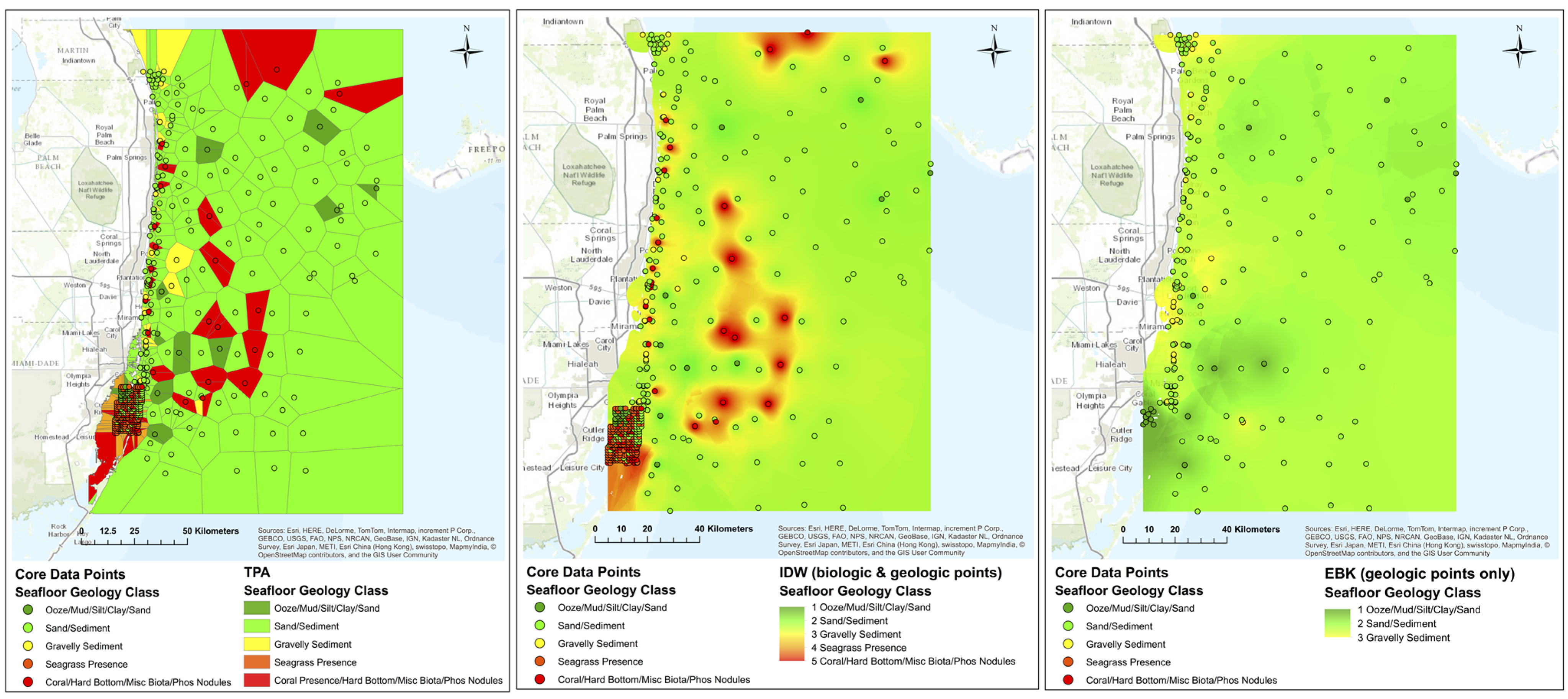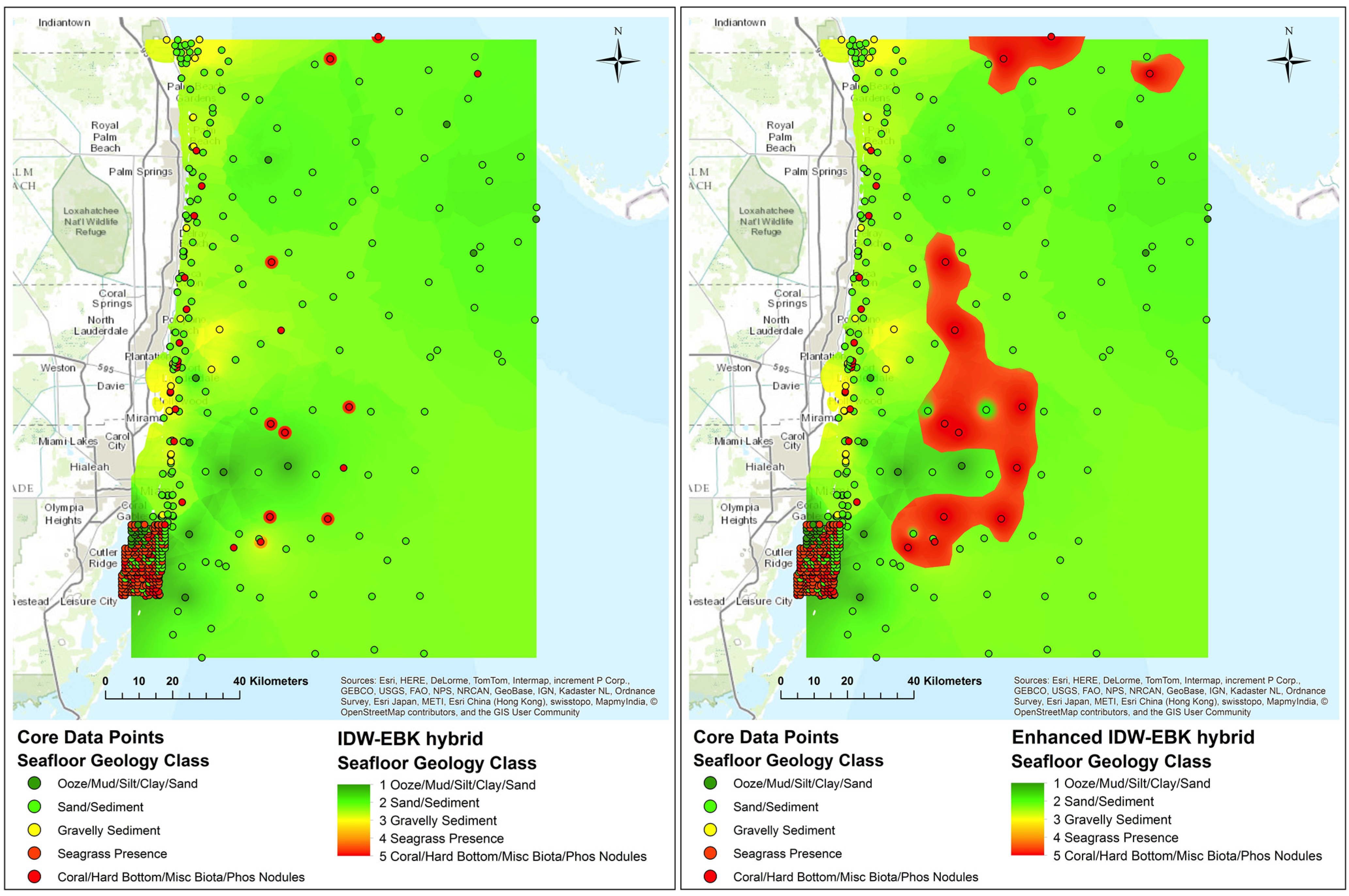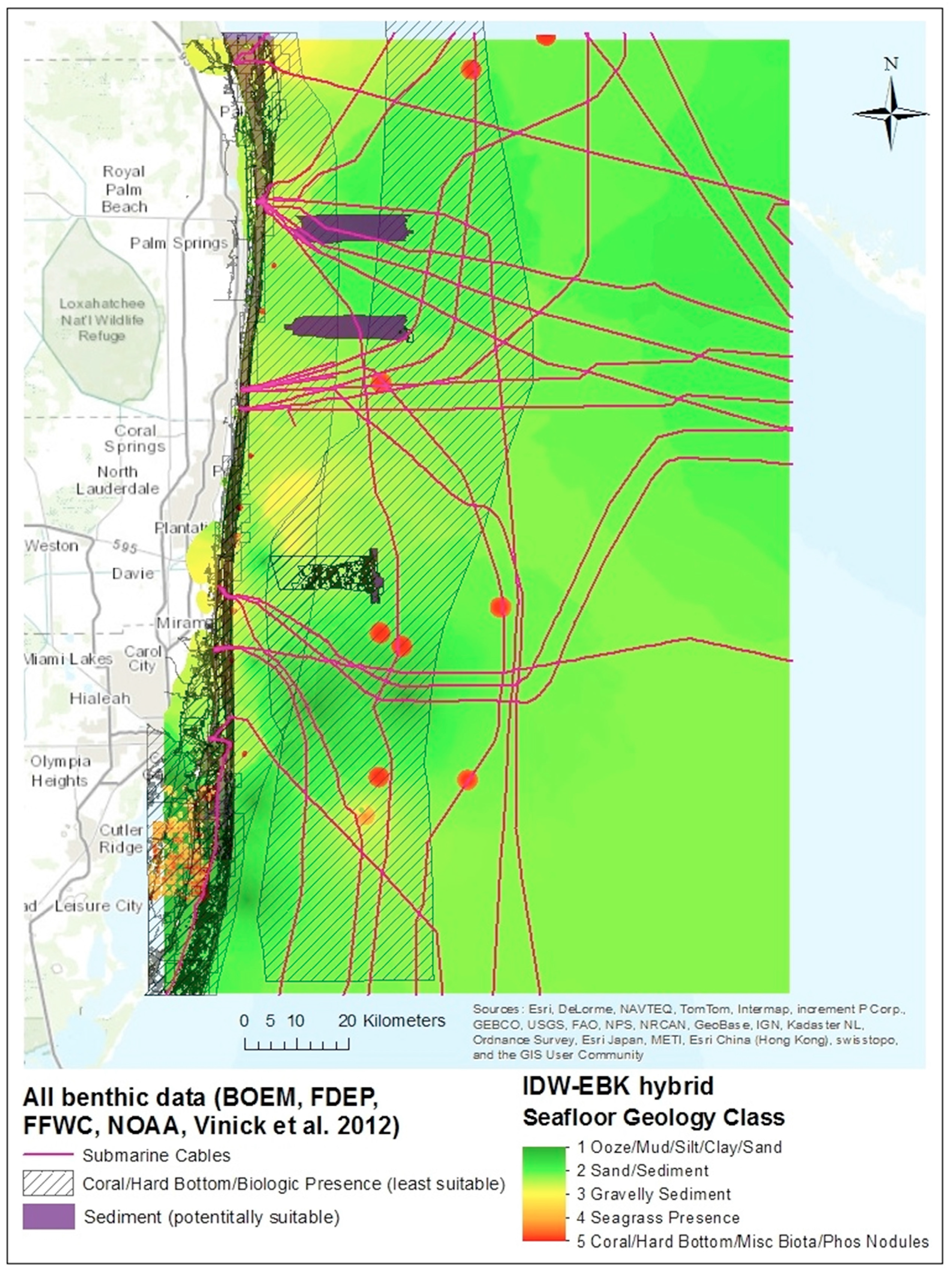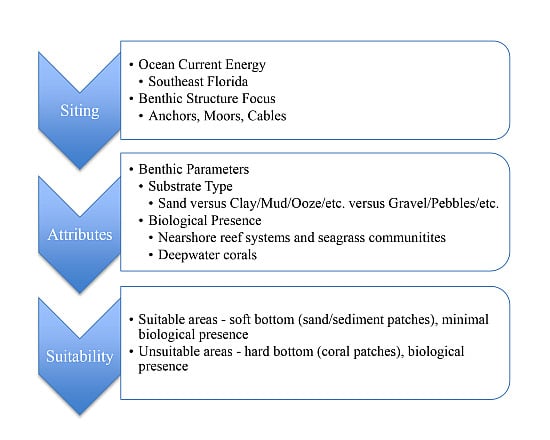Marine Benthic Habitats and Seabed Suitability Mapping for Potential Ocean Current Energy Siting Offshore Southeast Florida
Abstract
:1. Introduction
1.1. Laws and Regulations Guiding OCE Development
1.2. Benthic Characterization and Seabed Suitability for OCE
1.3. Geostatistical Methods for Seafloor Geology Mapping
2. Materials and Methods
2.1. Study Area

2.2. Data and Data Processing
2.2.1. Seafloor Geology and Bathymetry Data
2.2.2. Biological Data
2.2.3. Multibeam and Submarine Cable Data
2.3. Methods
2.3.1. Seabed Suitability for OCE Deployment: A Conceptual Framework
| Classes | Species/Habitat | Suitability |
|---|---|---|
| 1 | Coral/Hard bottom/Probable Hard bottom | 1 |
| 2 | Sinkhole/Probable sinkhole | 1 |
| 3 | FL slope—artificial | 1 |
| 4 | Unconsolidated Sediment | 5 |
| 5 | Seagrass | 1 |
| 6 | Manatee Habitat | 1 |
| 7 | Crocodile Habitat | 1 |
| 8 | Other | 1 |
| Classes | Seafloor Geology Type | Suitability |
|---|---|---|
| 1 | Coral Presence/Hard bottom/Rock Fragments/Limestone | 1 |
| 2 | Seagrass Presence | 1 |
| 3 | Miscellaneous Biota/Sponge Growth/Brown Tubes & Worm Tubes | 1 |
| 4 | Phosphorous Nodules/Phosphorous in Sand | 2 |
| 5 | Silt/Clay | 3 |
| 6 | Ooze/Sand/Mud | 3 |
| 7 | Gravelly Sediment | 4 |
| 8 | Sand/Sediment | 5 |
2.3.2. Geostatistical and Statistical Methods
3. Results and Discussion
3.1. Geostatistical Analysis


3.2. Statistical Analysis
| Paired Variables—Water Depth & Sediment | Valid (N) | Spearman (R) | Kendall (Tau) | Pearson (r) | p-value |
|---|---|---|---|---|---|
| Spearman rank correlation coefficient | 329 | −0.1556 | --- | 0.0047 | |
| Kendall’s Tau coefficient | 329 | --- | −0.1197 | 0.0012 | |
| Pearson correlation coefficient | 646 | --- | 0.2948 | 0.0000 | |
| Model: Piecewise linear regression with breakpoint; Least Squares Dependent variable: Grain size (mm); Independent variable: Water depth (m) Variance explained: 60.482%; R = 0.7777 | |||||
| Constant β01 | Water Depth1 (m) | Constant β02 | Water Depth2 (m) | Breakpoint | |
| 1.1808 | 0.000135 | 2.6566 | 0.000930 | 1.6445 | |


3.3. Sensitivity and Error Analysis
| Data Type | Number of Points | Source | Mean | Standard Deviation | CRV |
|---|---|---|---|---|---|
| IDW (biological & geological points) | 646 | Observed | 2.9365 | 1.2930 | 0.4403 |
| IDW (biological & geological points) | 646 | Interpolated | 2.8932 | 1.2998 | 0.4493 |
| EBK (geological points only) | 329 | Observed | 2.0365 | 0.4863 | 0.2388 |
| EBK (geological points only) | 329 | Interpolated | 1.9483 | 0.3319 | 0.1703 |
4. Conclusions
Acknowledgments
Author Contributions
Conflicts of Interest
References
- Hanson, H.P.; Bozek, A.; Duerr, A.E. The Florida Current: A clean but challenging energy resource. EOS Trans. Am. Geophys. Union 2011, 92, 29–36. [Google Scholar] [CrossRef]
- Southeast National Marine Renewable Energy Center (SNMREC). FAU’s Southeast. National Marine Renewable Energy Center Successfully Tests Research Turbine Offshore; Southeast National Marine Renewable Energy Center (SNMREC), 2014. Available online: http://snmrec.fau.edu/news/fau%E2%80%99s-southeast-national-marine-renewable-energy-center-successfully-tests-research-turbine#sthash.lL8w5BLA.dpuf (accessed on 25 October 2014).
- Hanson, H.P.; Skemp, S.H.; Alsenas, G.M.; Coley, C.E. Power from the Florida Current: A new perspective on an old vision. Bull. Am. Meteorol. Soc. 2010, 91, 861–867. [Google Scholar] [CrossRef]
- Kenny, A.J.; Cato, I.; Desprez, M.; Fader, G.; Schuttenhelm, R.T.E.; Side, J. An overview of seabed mapping technologies in the context of marine habitat classification. ICES J. Mar. Sci. 2003, 60, 411–418. [Google Scholar] [CrossRef]
- Keenan, G.; Sparling, C.; Williams, H.; Fortune, F. SeaGen Environmental Monitoring Programme Final Report; Royal Haskoning Enhancing Society: Edinburgh, UK, 2011. [Google Scholar]
- Stewart, P.L. Suspended Sediment Monitoring. In Environmental Assessment of the Bay of Fundy Tidal Power Project; Envirosphere Consultants Limited Windsor: Halifax, Nova Scotia, Canada, 2010. [Google Scholar]
- Portman, M.E. Marine renewable energy policy some U.S. and international perspectives compared. Oceanogr 2010, 23, 98–105. [Google Scholar] [CrossRef]
- Salcido, R. Siting offshore hydrokinetic energy projects: A comparative look at wave energy regulation in the Pacific Northwest. Golden Gate Univ. Envtl. Law J. 2011, 5, 109–158. [Google Scholar]
- Federal Energy Regulatory Commission (FERC). Legal Resources—Federal Statutes; Federal Energy Regulatory Commission (FERC): Washington, DC, USA, 2014. Available online: http://www.ferc.gov/legal/fed-sta.asp (accessed on 23 January 2015).
- Finkl, C.W.; Charlier, R. Electrical power generation from ocean currents in the Straits of Florida: Some environmental considerations. Renew. Sust. Energ. Rev. 2009, 13, 2597–2604. [Google Scholar] [CrossRef]
- Bureau of Ocean Energy Management (BOEM). Lease Issuance for Marine Hydrokinetic Technology Testing on the Outer Continental Shelf Offshore Florida Revised Environmental Assessment, OCS EIS/EA BOEM 2013–01140; Office of Renewable Energy Programs, U.S. Department of the Interior: Washington, DC, USA, 2013. Available online: http://www.boem.gov/Florida-Revised-EA-FONSI-August2013/ (accessed on 13 Febuary 2014).
- Vinick, C.; Riccobono, A.; Messing, C.G.; Walker, B.K.; Reed, J.K.; Rogers, S. Siting study for a Hydrokinetic Energy Project Located Offshore Southeastern Florida: Protocols for Survey Methodology for Offshore Marine Hydrokinetic Energy Projects; U.S. Department of Energy: Washington, DC, USA, 2012; pp. 1–100.
- Dubbs, L.; Keeler, A.; O’Meara, T. Permitting, risk and marine hydro-kinetic energy development. Electr. J. 2013, 26, 64–74. [Google Scholar] [CrossRef]
- Orth, R.J.; Carruthers, T.J.B.; Dennison, W.C.; Duarte, C.M.; Fourquerean, J.W.; Heck, K.L.; Hughes, R.A.; Kendrick, G.A.; Kenworthy, J.W.; Olyarnik, S.; et al. A global crisis for seagrass ecosystems. BioScience 2006, 56, 987–996. [Google Scholar] [CrossRef]
- McCann, J. Developing Environmental Protocols and Modeling Tools to Support. Ocean. Renewable Energy and Stewardship; National Oceanographic Partnership Program, OCS Study BOEM 2012–082, U.S. Department of the Interior, Bureau of Ocean Energy Management, Office of Renewable Energy Programs: Herndon, VA, USA, 2012. [Google Scholar]
- Valent, P.J.; Taylor, J.M.; Beard, R.M. OTEC Single Anchor Holding Capacities in Typical Deep Sea Sediments; U.S. Energy Research and Development Administration: Port Hueneme, CA, USA, 1976. [Google Scholar]
- Taylor, R.J. Interaction of Anchors with Soil and Anchor Design; U.S. Department of the Navy: Port Hueneme, CA, USA, 1982. [Google Scholar]
- Sound and Sea Technology. In Advanced Anchoring and Mooring Study; Oregon Wave Energy Trust: Portland, OR, USA, 2009.
- Van Zwieten, J.H.; Seibert, M.G.; Von Ellenreider, K. Anchor Selection Study for Ocean Current Turbines; Technical Report TR-12-003; Florida Atlantic University Southeast National Marine Renewable Energy Center: Boca Raton, FL, USA, 2012. [Google Scholar]
- Bennett, M.M.; Glasser, N.F. Glacial Geology: Ice Sheets and Landforms; Wiley: Hoboken, NJ, USA, 2009. [Google Scholar]
- Goff, J.A.; Jenkins, C.J.; Williams, S.J. Seabed mapping and characterization of sediment variability using the usSEABED database. Cont. Shelf Res. 2008, 28, 614–633. [Google Scholar] [CrossRef]
- Li, J. Predicting the Spatial Distribution of Seabed Gravel Content Using Random Forest, Spatial Interpolation Methods and Their Hybrid Methods. In Proceedings of the 20th International Congress on Modelling and Simulation, Adelaide, Australia, 1–6 December 2013.
- Verfaille, E.; van Lancker, V.; van Meirvenne, M. Multivariate geostatistics for the predictive modelling of the surficial sand distribution in shelf seas. Cont. Shelf Res. 2006, 26, 2454–2468. [Google Scholar] [CrossRef]
- Knotters, M.; Heuvelink, G.B.M.; Hoogland, T.; Walvoort, D.J.J. A Disposition of Interpolation Techniques; Wageningen University and Research Centre, Statutory Research Tasks Unit for Nature and the Environment: Wageningen, The Netherlands, 2010. [Google Scholar]
- Tchoukanski, I. Build. Thiessen Polygons. 2013. Available online http://www.ian-ko.com/ETGeoWizards/UserGuide/thiessenPolygons.htm (accessed on 3 November 2013).
- Johnston, K.; Ver Hoef, J.M.; Krivoruchko, K.; Lucas, N. Using ArcGIS Geostatistical Analyst; ESRI Press: Redlands, CA, USA, 2001. [Google Scholar]
- Krivoruchko, K.; Butler, K. Unequal Probability-Based Spatial Mapping; Esri: Redlands, CA, USA, 2013; Available online: http://www.esri.com/esrinews/arcuser/spring2013/~/media/Files/Pdfs/news/arcuser/0313/unequal.pdf (accessed on 14 March 2014).
- Krivoruchko, K. Empirical Bayesian Kriging; Esri: Redlands, CA, USA, 2012; Available online: http://www.esri.com/news/arcuser/ 1012/empirical-byesian-kriging.html (accessed on 7 April 2014).
- Charlier, R.H.; Justus, J.R. Ocean. Energies—Environmental, Economic and Technical Aspects of Alternative Power Sources; Elsevier Oceanography Series: Amsterdam, The Netherlands, 1993. [Google Scholar]
- Walker, B.K.; Riegl, B.M.; Dodge, R.E. Mapping Coral Reef Habitats in Southeast Florida Using a Combined Technique Approach. J. Coast. Res. 2008, 24, 1138–1150. [Google Scholar] [CrossRef]
- Walker, B.K.; Jordan, L.K.B.; Spieler, R.S. Relationship of fish assemblages and topographic complexity on southeastern Florida coral reef habitats. J. Coast. Res. 2009, 39–48. [Google Scholar] [CrossRef]
- Reed, J.K.; Weaver, D.; Pomponi, S.A. Habitat and fauna of deep-water Lophelia pertusa coral reefs off the southeastern USA: Blake Plateau, Straits of Florida, and Gulf of Mexico. Bull. Mar. Sci. 2006, 78, 343–375. [Google Scholar]
- South Florida Water Management District Staff. Canals in South Florida: A Technical Support Document (Appendices A-C); South Florida Water Management District: West Palm Beach, FL, USA, 2010.
- Reid, J.M.; Reid, J.A.; Jenkins, C.J.; Hastings, M.E.; Williams, S.J.; Poppe, L.J. usSEABED: Atlantic Coast Offshore Surficial Sediment Data Release; Data Series 118, Version 1.0; U.S. Geological Survey: Woods Hole, MA, USA, 2005.
- Poppe, L.J.; Williams, S.J.; Paskevich, V.F. USGS East.-Coast. Sediment. Analysis: Procedures, Database, and GIS Data; Open-File Report 2005–1001; U.S. Geological Survey: Woods Hole, MA, USA, 2005.
- National Oceanic and Atmospheric Administration (NOAA). The Index to Marine and Lacustrine Geological Samples (IMLGS); National Oceanic and Atmospheric Administration (NOAA): Boulder, CO, USA, 2013. Available online: http://www.ngdc.noaa.gov/mgg/curator (accessed on 7 Feburary 2014).
- Gardner, J.V.; Field, M.E.; Twichell, D.C. Geology of the United States’ Seafloor: The View from GLORIA; Cambridge University Press: Cambridge, UK, 1996. [Google Scholar]
- Florida Fish and Wildlife Commission-Fish and Wildlife Research Institute. Coral and Hard Bottom Habitats Florida; Florida Fish and Wildlife Commission-Fish and Wildlife Research Institute: Tallahassee, FL, USA, 2013; Available online: http://atoll.floridamarine.org/Data/Metadata/SDE_Current /coral_hardbottom_poly.htm (accessed on 17 November 2013).
- Florida Fish and Wildlife Commission-Fish and Wildlife Research Institute. Deepwater Coral HAPCs; Florida Fish and Wildlife Commission-Fish and Wildlife Research Institute: Tallahassee, FL, USA, 2008; Available online: http://ocean.floridamarine.org/efh_coral/zip/Final_DC_HAPC.shp.xml (accessed on 5 December 2013).
- National Oceanic Atmospheric Administration (NOAA). Critical Habitat Designations for the coastal US and US waters as of October 2012; Coastal Services Center: Charleston, SC, USA, 2012.
- National Oceanic Atmospheric Administration (NOAA). Submarine Cables; Coastal Services Center: Charleston, SC, USA, 2011.
- Van Cleve, F.B.; Judd, C.; Radil, A.; Ahmann, J.; Geerlofs, S.H. Geospatial Analysis of Technical and Economic Suitability for Renewable Ocean. Energy Development on Washington’s Outer Coast; Pacific Northwest National Laboratory: Richland, Washington, DC, USA, 2013.
- Nelson, W.G. Seagrasses and Protective Criteria: A Review and Assessment of Research Status; U.S. Environmental Protection Agency: Newport, OR, USA, 2009.
- Lirman, D.; Orlando, B.; Macia, S.; Manzello, D.; Kaufman, L.; Biber, P.; Jones, T. Coral communities of Biscayne Bay, Florida and adjacent offshore areas: diversity, abundance, distribution, and environmental correlates. Aquat. Conserv. Mar. Freshw. Ecosys. 2003, 13, 121–135. [Google Scholar] [CrossRef]
- Ewing, M.; Carpenter, G.; Windisch, C.; Ewing, J. Sediment distribution in the oceans: The Atlantic. Geol. Soc. Am. Bull. 1973, 84, 71–88. [Google Scholar] [CrossRef]
- Karl, H.A. Sediment. of the Sea Floor; United States Geological Survey: Boulder, CO, USA, 2006.
- Jelinski, D.E.; Wu, J. The modifiable areal unit problem and implications for landscape ecology. Landsc. Ecol. 1996, 11, 129–140. [Google Scholar] [CrossRef]
- Willmott, C.J.; Matsuura, K. Advantages of the mean absolute error (MAE) over the root mean square (RMSE) in assessing average model performance. Clim. Res. 2005, 30, 79–82. [Google Scholar] [CrossRef]
- Forkman, J. Estimator and tests for common coefficients of variation in normal distributions. Commun. Stat. Theor. M. 2009, 38, 233–251. [Google Scholar] [CrossRef]
- Coleman, C.; Swanson, D. On MAPE-R as a measure of cross-sectional estimation and forecast accuracy. J. Econ. Soc. Meas. 2007, 32, 219–233. [Google Scholar]
- Templeton, G.F. A Two-Step Approach for Transforming Continuous Variables to Normal: Implications and Recommendations for IS Research; Communications of the Association for Information Systems: Mississippi State, MS, USA, 2011; Available online: http://aisel.aisnet.org/cais/vol28/iss1/4/ (accessed on 12 January 2014).
- Zuur, A.; Ieno, E.N.; Elphick, C.S. Mixed effects models and extensions in ecology with R. Methods Ecol. Evol. 2010, 1, 3–14. [Google Scholar] [CrossRef]
- StatSoft. STATISTICA 12.0. 2013. Available online http://www.statsoft.com/Products/STATISTICA-Features/Version-12 (accessed on 14 October 2014).
- De Moustier, C.; Matsumoto, H. Seafloor acoustic remote sensing with multibeam echo-sounders and bathymetric sidescan sonar systems. Mar. Geophys. Res. 1993, 15, 27–42. [Google Scholar] [CrossRef]
© 2015 by the authors; licensee MDPI, Basel, Switzerland. This article is an open access article distributed under the terms and conditions of the Creative Commons Attribution license ( http://creativecommons.org/licenses/by/4.0/).
Share and Cite
Mulcan, A.; Mitsova, D.; Hindle, T.; Hanson, H.; Coley, C. Marine Benthic Habitats and Seabed Suitability Mapping for Potential Ocean Current Energy Siting Offshore Southeast Florida. J. Mar. Sci. Eng. 2015, 3, 276-298. https://doi.org/10.3390/jmse3020276
Mulcan A, Mitsova D, Hindle T, Hanson H, Coley C. Marine Benthic Habitats and Seabed Suitability Mapping for Potential Ocean Current Energy Siting Offshore Southeast Florida. Journal of Marine Science and Engineering. 2015; 3(2):276-298. https://doi.org/10.3390/jmse3020276
Chicago/Turabian StyleMulcan, Amanda, Diana Mitsova, Tobin Hindle, Howard Hanson, and Camille Coley. 2015. "Marine Benthic Habitats and Seabed Suitability Mapping for Potential Ocean Current Energy Siting Offshore Southeast Florida" Journal of Marine Science and Engineering 3, no. 2: 276-298. https://doi.org/10.3390/jmse3020276






